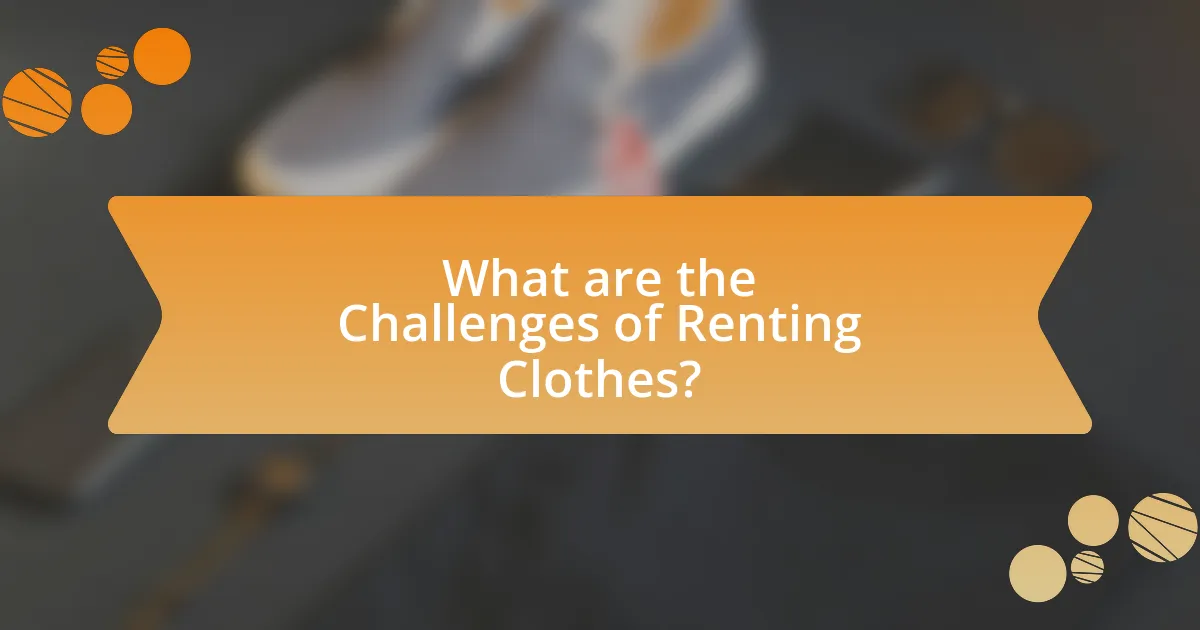The article focuses on the benefits of renting clothes as a sustainable alternative to purchasing garments. It highlights key advantages such as cost savings, access to high-quality fashion, and environmental sustainability, emphasizing how renting reduces waste and carbon emissions associated with the fashion industry. The article also discusses the financial benefits of renting, particularly for special occasions, and how it enhances personal style by providing diverse fashion options. Additionally, it addresses challenges related to renting, including size availability and hygiene concerns, while exploring future trends and innovations in the clothing rental market.

What are the Benefits of Renting Clothes?
Renting clothes offers several benefits, including cost savings, access to high-quality fashion, and environmental sustainability. Cost savings arise because renting allows individuals to wear designer or trendy items without the high purchase price, making fashion more affordable. Access to high-quality fashion is enhanced as renters can enjoy a variety of styles and brands that may otherwise be out of reach. Environmental sustainability is a significant benefit, as renting reduces waste and the demand for new clothing production, contributing to a decrease in the fashion industry’s carbon footprint. According to a report by the Ellen MacArthur Foundation, the fashion industry is responsible for 10% of global carbon emissions, and renting clothes can help mitigate this impact by promoting a circular economy.
How does renting clothes contribute to sustainability?
Renting clothes contributes to sustainability by reducing the demand for new clothing production, which is resource-intensive and environmentally damaging. The fashion industry is responsible for approximately 10% of global carbon emissions and significant water consumption; by renting instead of buying, consumers can help decrease these impacts. Studies indicate that renting can lead to a reduction in clothing waste, as it promotes a circular economy where garments are reused multiple times, thus extending their lifecycle and minimizing landfill contributions.
What environmental impacts are reduced by renting instead of buying?
Renting clothes instead of buying significantly reduces environmental impacts such as resource consumption, waste generation, and carbon emissions. When individuals rent clothing, they contribute to a circular economy that minimizes the demand for new textile production, which is responsible for approximately 20% of global wastewater and 10% of global carbon emissions. Additionally, renting reduces the volume of discarded clothing in landfills, where over 92 million tons of textile waste are generated annually. By choosing to rent, consumers help decrease the overall environmental footprint associated with the fashion industry.
How does renting clothes promote a circular economy?
Renting clothes promotes a circular economy by extending the lifecycle of garments and reducing waste. When consumers rent clothing instead of purchasing it, they contribute to a system where items are reused multiple times, minimizing the demand for new production. This practice decreases the environmental impact associated with manufacturing, such as resource extraction and pollution. According to a report by the Ellen MacArthur Foundation, the fashion industry could reduce its greenhouse gas emissions by 44% by 2030 through circular practices like clothing rental. Thus, renting clothes not only supports sustainable consumption but also fosters a more resource-efficient economy.
What financial advantages does renting clothes offer?
Renting clothes offers significant financial advantages, primarily by reducing overall clothing expenses. Consumers save money by avoiding the high upfront costs associated with purchasing new garments, especially for items that may only be worn a few times, such as formal wear or seasonal outfits. According to a report by the Global Data, the clothing rental market is projected to reach $1.96 billion by 2023, indicating a growing trend towards cost-effective fashion solutions. Additionally, renting eliminates the need for maintenance costs, such as dry cleaning and repairs, further enhancing financial savings.
How can renting clothes save money compared to purchasing?
Renting clothes can save money compared to purchasing by significantly reducing upfront costs and eliminating the need for long-term investment in items that may only be worn once or twice. For instance, renting a designer dress for an event typically costs between $30 to $100, while purchasing the same dress could range from $200 to $1,000. This cost-effectiveness is particularly beneficial for special occasions where the likelihood of repeated use is low. Additionally, renting allows consumers to access a wider variety of styles without the financial burden of ownership, enabling them to stay fashionable without overspending.
What are the cost implications of renting versus buying for special occasions?
Renting for special occasions typically incurs lower upfront costs compared to buying, as rental fees are generally a fraction of the purchase price. For example, renting a formal dress may cost between $50 to $200, while purchasing the same dress could range from $300 to over $1,000. Additionally, renting eliminates long-term maintenance costs, such as cleaning and storage, which can add up over time. According to a study by the Fashion Institute of Technology, consumers can save up to 80% on clothing expenses by opting to rent instead of buy for infrequent use. Thus, renting is often more cost-effective for special occasions, especially when considering the limited frequency of wear.
How does renting clothes enhance personal style?
Renting clothes enhances personal style by providing access to a diverse range of fashion options without the commitment of purchasing. This flexibility allows individuals to experiment with different looks, trends, and designers, thereby fostering a unique personal aesthetic. Studies indicate that 63% of consumers feel that renting clothing helps them express their individuality, as it enables them to wear outfits that align with their current mood or occasion without the financial burden of buying.
What variety of options does renting provide for fashion choices?
Renting provides a diverse array of fashion choices, including access to high-end designer pieces, seasonal trends, and unique styles that may not be feasible to purchase outright. This variety allows individuals to experiment with different looks without the commitment of buying, catering to various occasions such as weddings, parties, or everyday wear. According to a report by McKinsey & Company, the rental fashion market is projected to grow significantly, indicating a rising consumer preference for flexible and diverse wardrobe options.
How can renting clothes help in trying new trends without commitment?
Renting clothes allows individuals to explore new fashion trends without the long-term commitment of purchasing items. This approach enables consumers to experiment with various styles and brands, facilitating a more dynamic wardrobe without the financial burden of buying each piece. According to a report by the Business of Fashion, the rental market is projected to grow significantly, indicating a rising consumer preference for flexible fashion options. By renting, individuals can assess whether a trend suits their personal style before making a purchase, thus promoting informed buying decisions and reducing waste associated with fast fashion.

What are the Challenges of Renting Clothes?
The challenges of renting clothes include limited availability of sizes and styles, potential for damage fees, and concerns about cleanliness and hygiene. Limited availability can restrict options for consumers, as not all sizes or styles may be in stock, leading to dissatisfaction. Additionally, rental services often impose fees for damages, which can deter customers from renting due to the fear of incurring extra costs. Concerns about cleanliness arise from the fact that multiple users wear the same items, prompting questions about the thoroughness of cleaning processes between rentals. These challenges can impact the overall experience and perception of clothing rental services.
What are the potential downsides of renting clothes?
The potential downsides of renting clothes include limited availability, potential for poor fit, and additional costs. Limited availability can restrict access to desired styles or sizes, as rental companies may not stock every item in every size. Poor fit can lead to dissatisfaction, as customers may receive items that do not match their measurements or preferences. Additionally, rental services often include extra fees for cleaning, damage, or late returns, which can increase the overall cost compared to purchasing clothing outright.
How does the quality of rented clothes compare to purchased items?
The quality of rented clothes often matches or can exceed that of purchased items, depending on the rental service and the brand. Many rental companies curate high-quality garments from reputable designers, ensuring that the items are well-maintained and in excellent condition. For instance, a study by the Ellen MacArthur Foundation highlights that rental services frequently offer access to premium brands that consumers might not afford to buy outright, thus elevating the perceived quality of rented clothing. Additionally, rental companies typically inspect and clean garments thoroughly after each use, which can enhance their longevity and appearance compared to some purchased items that may not receive the same level of care.
What are the concerns regarding hygiene and cleanliness in rented clothing?
Concerns regarding hygiene and cleanliness in rented clothing primarily involve the potential for the transmission of bacteria, viruses, and allergens from previous users. Studies indicate that clothing can harbor pathogens, with research showing that items like dresses and suits can carry harmful microorganisms if not properly sanitized. Additionally, the effectiveness of cleaning methods used by rental services can vary, raising questions about whether garments are adequately disinfected between rentals. For instance, a survey by the International Journal of Environmental Research and Public Health highlights that 60% of consumers express concerns about the cleanliness of rented apparel, emphasizing the need for stringent hygiene protocols in the clothing rental industry.
How can consumers overcome challenges when renting clothes?
Consumers can overcome challenges when renting clothes by thoroughly researching rental companies and understanding their policies. This approach allows consumers to identify reputable services that offer clear return guidelines, quality assurance, and customer support. For instance, a study by the Ellen MacArthur Foundation highlights that transparency in rental agreements significantly enhances consumer trust and satisfaction. Additionally, consumers can read reviews and seek recommendations to ensure they select a service that meets their needs, thereby minimizing the risk of poor experiences.
What tips can help ensure a positive renting experience?
To ensure a positive renting experience, it is essential to thoroughly research rental companies and read customer reviews. This practice helps identify reputable businesses with a history of customer satisfaction. Additionally, understanding rental terms, including fees, return policies, and cleaning requirements, is crucial to avoid unexpected charges. Clear communication with the rental company regarding expectations and any specific needs can further enhance the experience. According to a survey by the Rental Fashion Association, 78% of customers reported a more favorable experience when they were well-informed about rental policies and procedures.
How can one choose reliable rental services?
To choose reliable rental services, one should prioritize companies with positive customer reviews and transparent policies. Researching online platforms like Trustpilot or Yelp can provide insights into customer experiences, highlighting the reliability of the service. Additionally, verifying the rental service’s credentials, such as industry certifications or affiliations with reputable organizations, can further ensure trustworthiness. A study by the Ellen MacArthur Foundation indicates that businesses with strong sustainability practices, including transparent rental processes, tend to have higher customer satisfaction rates, reinforcing the importance of reliability in rental services.

What Future Trends are Emerging in Clothing Rentals?
Future trends in clothing rentals include the rise of subscription-based models, increased integration of technology, and a focus on sustainability. Subscription services allow consumers to access a rotating wardrobe for a fixed monthly fee, promoting a more flexible approach to fashion. Technology, such as augmented reality and AI, enhances the online shopping experience by allowing customers to visualize how clothing will look on them before renting. Additionally, the emphasis on sustainability drives brands to offer eco-friendly options, as consumers increasingly seek to reduce their environmental impact. According to a report by McKinsey & Company, the global clothing rental market is projected to grow significantly, indicating a shift in consumer behavior towards more sustainable fashion choices.
How is technology influencing the clothing rental market?
Technology is significantly influencing the clothing rental market by enhancing accessibility, streamlining operations, and improving customer experience. Online platforms and mobile applications allow consumers to easily browse, select, and rent clothing from the comfort of their homes, increasing market reach. For instance, companies like Rent the Runway utilize sophisticated algorithms to recommend styles based on user preferences, which boosts user engagement and satisfaction. Additionally, advancements in logistics technology enable efficient inventory management and faster delivery times, making the rental process more convenient. According to a report by Grand View Research, the global online clothing rental market is expected to reach $1.96 billion by 2025, highlighting the impact of technology on market growth and consumer adoption.
What role do mobile apps play in the convenience of renting clothes?
Mobile apps significantly enhance the convenience of renting clothes by providing users with easy access to a wide range of clothing options at their fingertips. These applications streamline the rental process through user-friendly interfaces that allow customers to browse, select, and reserve items quickly, often with just a few taps. For instance, a study by Statista in 2021 indicated that 70% of consumers prefer using mobile apps for shopping due to their efficiency and ease of use. Additionally, mobile apps often include features such as personalized recommendations, real-time inventory updates, and secure payment options, which further simplify the renting experience. This integration of technology not only saves time but also encourages sustainable fashion practices by making it easier for consumers to choose rental options over purchasing new clothing.
How is data analytics shaping personalized rental experiences?
Data analytics is shaping personalized rental experiences by enabling companies to tailor offerings based on individual customer preferences and behaviors. Through the analysis of data such as past rental history, browsing patterns, and customer feedback, rental platforms can recommend specific items that align with a user’s style and needs. For instance, a study by McKinsey & Company found that personalized recommendations can increase conversion rates by up to 30%, demonstrating the effectiveness of data-driven insights in enhancing customer satisfaction and engagement in the rental market.
What innovations are expected in the clothing rental industry?
Innovations expected in the clothing rental industry include advancements in technology, such as AI-driven personalization and improved logistics systems. AI algorithms can analyze customer preferences and body types to recommend tailored outfits, enhancing user experience and satisfaction. Additionally, companies are investing in sustainable practices, like eco-friendly materials and circular economy models, which reduce waste and promote recycling. For instance, a report by McKinsey & Company highlights that the rental market is projected to grow significantly, driven by consumer demand for sustainable fashion options. These innovations not only cater to changing consumer preferences but also align with broader environmental goals.
How are sustainable practices being integrated into rental services?
Sustainable practices are being integrated into rental services through the implementation of eco-friendly materials, efficient logistics, and circular economy principles. Rental services are increasingly sourcing clothing made from organic or recycled fabrics, which reduces environmental impact. Additionally, many companies are optimizing their supply chains to minimize carbon footprints by using local suppliers and eco-conscious shipping methods. According to a report by McKinsey & Company, the rental market can reduce clothing consumption by up to 80%, significantly lowering waste and resource use. This integration of sustainability not only appeals to environmentally conscious consumers but also aligns with global efforts to combat climate change.
What new business models are emerging in clothing rentals?
New business models emerging in clothing rentals include subscription services, peer-to-peer rental platforms, and rental marketplaces. Subscription services, such as Rent the Runway, allow customers to pay a monthly fee for access to a rotating wardrobe, promoting sustainability by reducing fast fashion consumption. Peer-to-peer rental platforms, like Poshmark, enable individuals to rent their clothing to others, fostering a community-driven approach to fashion. Rental marketplaces, such as HURR Collective, connect renters with a variety of clothing options, emphasizing the sharing economy and reducing waste. These models reflect a shift towards more sustainable consumption patterns in the fashion industry.
What are the best practices for renting clothes effectively?
The best practices for renting clothes effectively include selecting a reputable rental service, understanding sizing and fit, and planning ahead for events. Choosing a well-reviewed rental platform ensures quality and reliability, as services like Rent the Runway and HURR Collective have established trust through customer feedback and return policies. Knowing your measurements and referring to the rental service’s sizing guides helps avoid fit issues, which is crucial since clothing can vary significantly between brands. Additionally, reserving items well in advance allows for any necessary exchanges or adjustments, enhancing the overall experience and ensuring the desired outfit is available. These practices contribute to a more efficient and satisfying clothing rental experience.



